There are moments while surfing the net that trigger memories of long ago popular knitting patterns. One such is the piano scarf, usually knit double bed. For a while, knit QR codes, or even bar codes were “the thing”. Decades ago, long before online converters and easily available information, there were a few articles on converting alphabets to binary codes for knitting. Far more recent versions with different interpretations: using ones and zeros for pattern, hand-knit https://knitty.com/ISSUEwinter06/PATTbinary.html 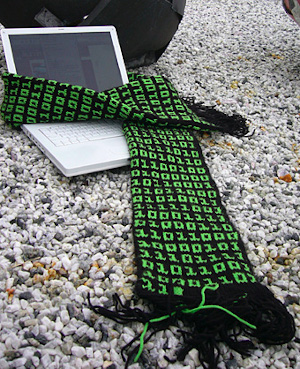 A collection of machine-knit versions https://knithacker.com/2017/03/sam-meechs- knitted-binary-scarves/
A collection of machine-knit versions https://knithacker.com/2017/03/sam-meechs- knitted-binary-scarves/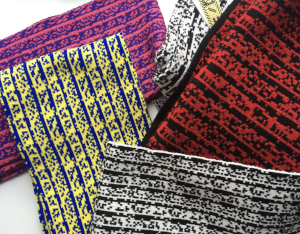 I prefer the more abstract to the literal interpretation using numbers, happen to have a 12 letter first name, and thought I would go for converting it. Because of the number of letters involved, the repeat would of necessity have to be a vertical one. I used 2 converters to double-check the result, noticing that when one of the letters repeats, the code for each of the 2 letters is slightly different. Of the many choices, I used these converters https://www.prepostseo.com/tool/text-to-binary-converter, and https://www.convertbinary.com/text-to-binary/
I prefer the more abstract to the literal interpretation using numbers, happen to have a 12 letter first name, and thought I would go for converting it. Because of the number of letters involved, the repeat would of necessity have to be a vertical one. I used 2 converters to double-check the result, noticing that when one of the letters repeats, the code for each of the 2 letters is slightly different. Of the many choices, I used these converters https://www.prepostseo.com/tool/text-to-binary-converter, and https://www.convertbinary.com/text-to-binary/
Each letter is converted to 8 digits, making results easily adaptable for punchcard use. 01000001 01101100 01100101 01110011 01110011 01100001 01101110 01100100 01110010 01101001 01101110 01100001. My spreadsheet in Numbers refused to allow me to enter the 0s at the start of each sequence, so the 0 has its own column, and in the larger chart, it is illustrated as a blank vertical row 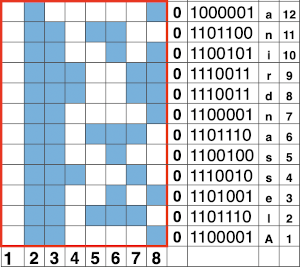 The problem if such repeats are used for fair isle knitting is that the results are likely to separate along those long vertical lines and to curl to the purl side even if blocked flat to start with. Converting the pattern for use on the double bed with any DBJ technique and backing is the better solution. My results, with letters from the bottom up
The problem if such repeats are used for fair isle knitting is that the results are likely to separate along those long vertical lines and to curl to the purl side even if blocked flat to start with. Converting the pattern for use on the double bed with any DBJ technique and backing is the better solution. My results, with letters from the bottom up 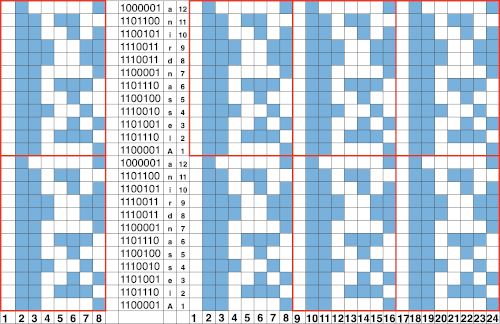 Programming the width of the number of needles to be used for the “scarf”, allows for the addition of a border stitch (or more) on either side. Start the base with and use the dark color for your first knit row from right to left in most of the automatic 2 color separations. Here is a tentative 72+1 stitch version
Programming the width of the number of needles to be used for the “scarf”, allows for the addition of a border stitch (or more) on either side. Start the base with and use the dark color for your first knit row from right to left in most of the automatic 2 color separations. Here is a tentative 72+1 stitch version 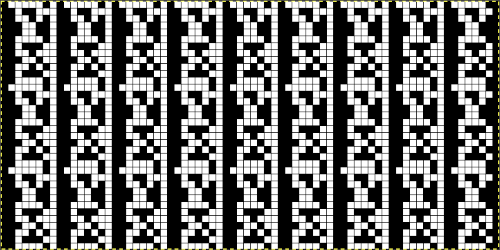 The related swatch, knit nearly 4 years later, forgetting that the 930 automatically mirrors text and motifs, so my repeat is mirrored horizontally 🙁
The related swatch, knit nearly 4 years later, forgetting that the 930 automatically mirrors text and motifs, so my repeat is mirrored horizontally 🙁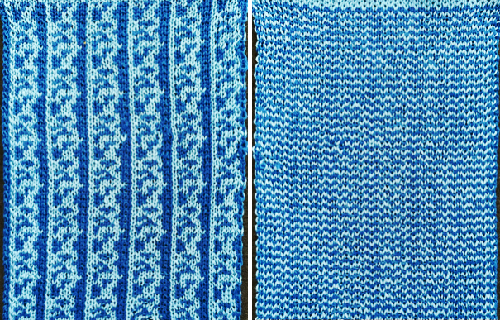 If numbers are your preference, with a bit of playing around digits may be adjusted in width and height
If numbers are your preference, with a bit of playing around digits may be adjusted in width and height  going a bit bolder, the 8 individual letters as numbers could repeat horizontally across each design row.
going a bit bolder, the 8 individual letters as numbers could repeat horizontally across each design row.  A repeat for the letter AX2 planned for the first segment of an 82 stitch wide scarf,
A repeat for the letter AX2 planned for the first segment of an 82 stitch wide scarf,  with the number of knit rows between each letter group started at 5. An attempt to visualize the final look using only the letter A.
with the number of knit rows between each letter group started at 5. An attempt to visualize the final look using only the letter A.
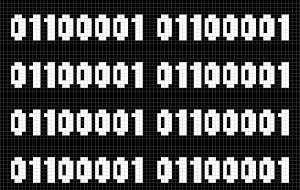 G carriages may be used to knit the same patterns in knit and purl stitch combinations.
G carriages may be used to knit the same patterns in knit and purl stitch combinations.
I’m with Jared – very cool. So fun and lots of room for creativity. Love these examples.
How cool is that? Very cool! I like your interpretation. Having spent a lifetime programming, decades ago, everything was in ASCII and binary.
Jared Scott